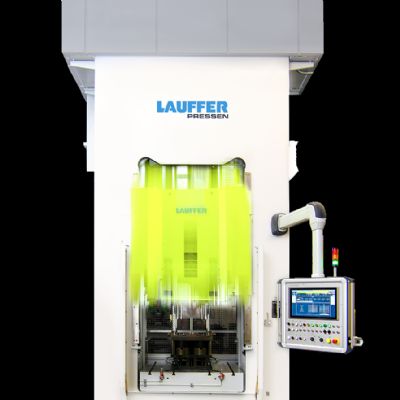About Transfer Automation
“The marriage of servo-based transfer systems to servo presses is a good one,” says Linear Transfer’s Stirrett, on the topic of complete servo-based stamping systems. “And, that marriage has become stronger with the introduction, a few years ago, of transfer interfaces by the press builders. Such interfaces allow a transfer system (from any supplier) to obtain a continuous signal from the press, so that the transfer-system motion control can precisely follow the motion of the press, completely synchronized.”
Stirrett notes that he’s seen servo-based transfer presses operating “like night and day” when compared to conventional mechanical transfer presses.
“In the medical industry,” he offers as an example, “I’ve seen multiple stations of a transfer die running in a conventional press replaced with one station, leveraging the press’s ability to control forming speed at different points in the press stroke. There’s no question that this technology is minimizing the number of die stations and simplifying the forming process.”
On the transfer-system front, Stirrett will describe two specific technology trends:
• The use of linear motors in very high-speed and high-acceleration applications, to decrease system complexity by eliminating belts, gear boxes, ballscrews and the like; and
• The use of carbon-fiber booms to reduce transfer-system weight and, therefore, increase system capacity.
“Last but not least,” Stirrett adds, “servos following servos (press to transfer system) creates a much cleaner, repeatable and robust process. The ability to run in pendulum mode, along with the quick response capabilities of a servo press, eliminate the wasted angle and timing that is lost in a typical cycle. These characteristics also compensate for press stopping time on a servo press when compared to a standard mechanical press.
Optimizing the Working Energy System
“In a servo press, with the servo motors supplying continuously variable working energy at any speed,” explains Stamtec’s Ellard, “a servo press can optimize productivity based specifically on time-optimized motion profiles. Those profiles must fit within the specific press and process parameters—maximum motor speed, the available working area during the stroke, maximum slide speed and optimal forming speed of the slide—but are more or less infinitely variable within those parameters.”
Ellard, along with Siemens’ Barry, will dive deeply into this subject, while explaining how and why servo technology optimizes flexibility in the pressroom. Ellard also stresses that, “with all of the flexibility and possibilities, it might seem like a servo press will immediately simplify a stamper’s life. In many cases it will, but stampers must actually be more knowledgeable about their tooling than they are when specifying a conventional mechanical press, so that they make the right choices when working with their supplier to configure a new servo press.
“The ability of a servo press to provide optimized productivity,” he continues, “comes at the potentially high expense of peak-current demands from the servo system. There are two ways to minimize energy use—optimize the drive configuration to match the application of the press, to avoid oversizing the system; and employ some level of energy-optimization technology.” Ellard and Barry will expound on these options.
Adds Barry: “Lack of any type of energy management can significantly impact the total cost of ownership, and every servo-press design has its unique energy requirements. This results in specific energy-management calculations. The press must be optimally configured for speed, energy and energy provided at a specific distance off bottom.
“There are specific opportunities for stampers to save money here,” he continues. “Stampers must know what they are signing up for when they invest in a servo press. For example, a 1000-ton conventional mechanical press with a 250-hp drive may require 400 A of input power, while a 1000-ton servo press might require 2000 A (with no energy management). This is a huge disparity, but when understood and planned for using the right energy-management approach, it can be mitigated.”
Energy-management strategy, a primary discussion point for Ellard and Barry at the Servo Technology Experience, centers on the use of energy-storage devices integrated with and controlled by the motion system. A press lacking such add-ons requires all of the mechanical power from the motor to be covered by the infeed and line supply. However, with the proper energy-storage devices in line, the servo-press supply system need only provide power for the actual work done and system losses. This greatly minimizes the infrastructure required, and installation costs.
“We see ROIs from these energy-management systems at around 18 months,” Barry says. That justification process will become clear during his presentation in Nashville.
In-Process Quality Control—More ROI Fuel
There’s even more to consider when cost-justifying a servo press, it turns out, in addition to the press-stroke flexibility afforded by the servo-press drive system. That flexibility not only pays dividends during the stamping process, but it also can promote in-die measurement, inspection and quality control. Yes—stampers can perform dimensional inspection in the die (without slowing the process), and then divide good- and bad-parts streams, eliminating the need for a secondary inspection and verification station in the die, or the need for an additional post-production inspection process. That’s the gist of the presentation from Link Systems’ Barrett.
“While we can and do set up in-die measurement and inspection stations with conventional presses,” Barrett says, “the ability to slow or pause the ram with a servo press takes this to the next level. There are certain types of measurements that are difficult or impossible to make inside of a conventional press that become much simpler to make with a servo press. For example, we can pause on the upstroke and fire a PLS to bring in an LVDT or other device. We see this as very viable in the aerospace or medical industries, for example, where you often need 100-percent part verification.”
Barrett also will explain to conference attendees how the flexibility of press-automation equipment truly comes to light when matched with servo presses. For example, consider an application where a servo press passes through bottom three times on one station.
“We can fire a PLS at a particular crank angle,” he explains, “but only on the third pass through, for example. Or we can gather data from the die-protection sensors on the upstroke after a bend in high-strength steel has been made, or we can bring in different sets of limits on the tonnage monitor for each pass through bottom.
“In most cases we’re seeing this type of work being done at full production speed,” Barrett concludes. “My presentation will share some details, prescribe best practices for sensor selection and use, and emphasize the need for diligent operator training to ensure it all comes together.”
For more information on the Servo Technology Experience, presented by MetalForming magazine and the Precision Metalforming Association, visit www.metalformingmagazine.com/servo. MFView Glossary of Metalforming Terms
See also: Link Systems, Stamtec, Inc., Komatsu America Industries, LLC Press Technology Division, Siemens Industry, Inc., Andritz Schuler
Technologies: Pressroom Automation, Sensing/Electronics/IOT, Stamping Presses







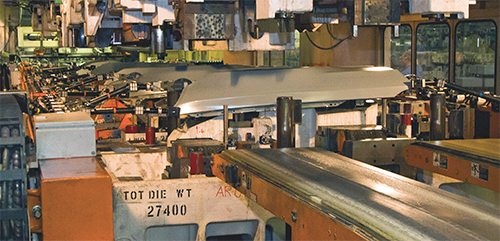
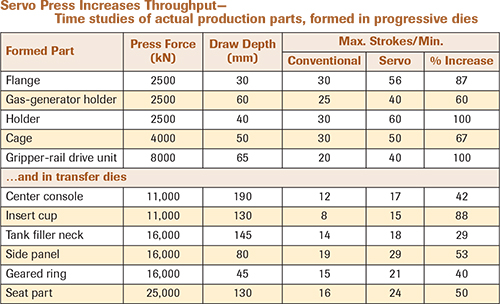
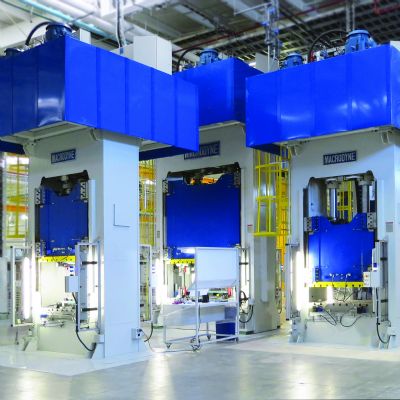
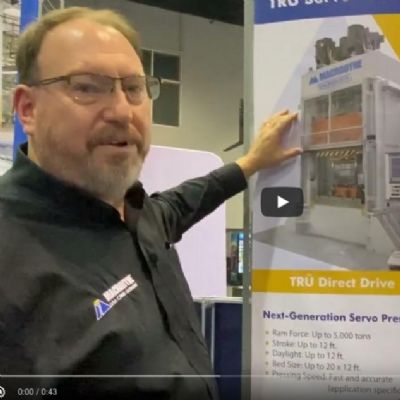
 Video
Video